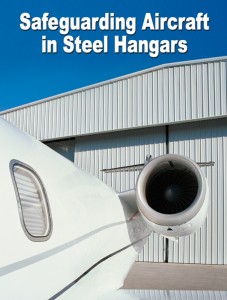From Red-Iron Hangars to the Wild Blue Yonder
Steel hangars are almost as old as manned flight itself. From the early days of flight, protecting the sometimes fragile aircraft from harm was mandatory.
 Flying into History
Flying into History
We often forget that the earliest successful manned flights were not airplanes, but gas balloons.
The first manned balloon flight in America was in 1793, when the Frenchman Jean-Pierre Blanchard flew from Philadelphia to Deptford, NJ. Surprisingly, the first silk parachute jump was also made from a hot air balloon in 1797. During the Civil War, hot air balloons were used for reconnaissance.
However, the volatile hydrogen and helium-filled balloons and dirigibles made flight very dangerous.
With the advent fixed wing aircraft, manned flight became not only possible, but commonplace.
The Evolution of Hangars
Early attempts at vertical flying aircraft were gyrating, shuddering contraptions that seem laughable now— yet each failed attempt was actually another step forward.
You cannot figure out what works until you eliminate what does not work.
So it was for aviation pioneers Orville and Wilbur Wright. Their first attempt at a hangar was a wooden shed they constructed in 1902. The Wrights built the hangar to house and repair their experimental glider aircraft at Kill Devil Hills, NC. The structure lasted only a few months it became being badly damaged by storms.
As man extended his horizons with flight, he also expanded his need for wider, stronger, safer hangars for his flying machines.
Engineers quickly switched to steel as the framing material of choice for hangars.
Steel is stronger than wood. It spans father without load-bearing supports. That’s why steel is the material of choice for bridges as well as barns, manufacturing facilities, recreational structures, warehouses, and aircraft hangars.
Glorified Garages for Aircraft?
Some people consider hangars to be mere garages for aircraft. However, hangars are actually engineering works of art.
The size range of hangars is as vast as the aircraft themselves. Modern hangars are built specifically to house and protect small fixed wing planes, helicopters, private jets, jumbo jets, military cargo planes, or even blimps.
Precisely designed to shelter a single type of aircraft— or a mix of flying marvels— hangars must allow room for safe egress and simple maneuverability. Commercial and military hangars may also contain crew berthing, fabrication rooms, maintenance and testing areas, lobbies, repair shops, offices, and utility rooms.
Today hangars fall into five basic size classifications, based on the structures width:
- Small: less than 100’
- Medium: 101’ to 200’
- Large: 201’ to 300’
- Extra-large: 301’ to 400’
- Extra-extra-large: 401’ or larger
The Advantages of Steel Hangars and Buildings
The advantages of pre-engineered steel structures make them the logical choice for aircraft hangars— and all other commercial and industrial structures.
- CONSISTENT QUALITY: Steel’s strength remains verifiable and consistent. Every piece of steel of a certain gauge performs exactly as all others like it, promising perfect performance.
- COST EFFECTIVE: The competitive pricing of steel building construction and operation earns the building projects of perceptive buyers. It is no wonder steel now dominates both the commercial (65%) and industrial (95%) low-rise building markets.
- DURABLE: Steel aircraft hangars and buildings defy aging. They hold their good looks and value for decades longer than other types of structures. Quality metal building systems provide built-in resistance to damage from fire, lightning, strong winds, earthquakes, snows, mold, and termites.
- GREEN: As the most recycled material on the planet, steel wins the hearts of eco-conscious building buyers. The U.S. Green Building Council calls steel framing “the logical and responsible choice for Green Building.”
- EXPANDABLE: Enlarging a metal hangar at either endwall simply requires ordering more frames to match the original structure.
Rhino Steel Hangars
Any aircraft is a sizable investment. It makes sense to choose the strongest shelter possible for the security of such a valuable asset.
RHINO Steel Building Systems provides premium metal structures and first-class customer service for aircraft hangars and other industrial and commercial structures. Our exceptional building system sets us apart from the common herd of metal building. We call these value-added benefits “The RHINO Difference.”
The RHINO Difference includes:
- Bolt-together construction for 33% faster construction
- High-strength self-drilling screws with durable, waterproof sealing washers
- Base trim formed to fit the wall material, eliminating rust issue— and saving about $300 on concrete costs
- Matching framed opening trim for a sharp, professional appearance
- Die-formed ridge caps for a tighter, more waterproof roof
- Closure strips for all eaves, base, and roof— for additional weatherproofing
- Extra overlap on steel panels for increased strength and improved water resistance
- 26-gauge, high-tensile steel, purlin bearing rib-roofed (PBR) roof and wall panels (rather than cheaply-made R-panels) for more metal-to-metal contact, increased strength, and exceptional weatherproofing
- Prints stamped by an engineer certified in that state, for quick approval
- Letter of Certification
- Construction DVD and Erection Manuel
Two things confirm our customers appreciate The RHINO Difference: our high repeat and referral rate and our A+ rating with the Better Business Bureau.
Competitively priced RHINO steel hangars and metal buildings incorporate features not available with cut-rate metal structures.
All RHINO steel-framed structures meet, or even exceed, all current the local building codes—guaranteed— for the lifetime of the structure.
RHINO steel aircraft hangar buildings are not only the smart building choice, they are also the environmentally responsible building choice, since steel is the most recycled material in the world.
Your aircraft deserves the best protection available, so experience The Rhino Difference for yourself. Build your next aviation shelter, hangar, or other metal building project with a RHINO-tough steel building system.
For more details about building RHINO steel hangars or other building needs, speak to a metal building specialist today. Call RHINO at 940.383.9566.
